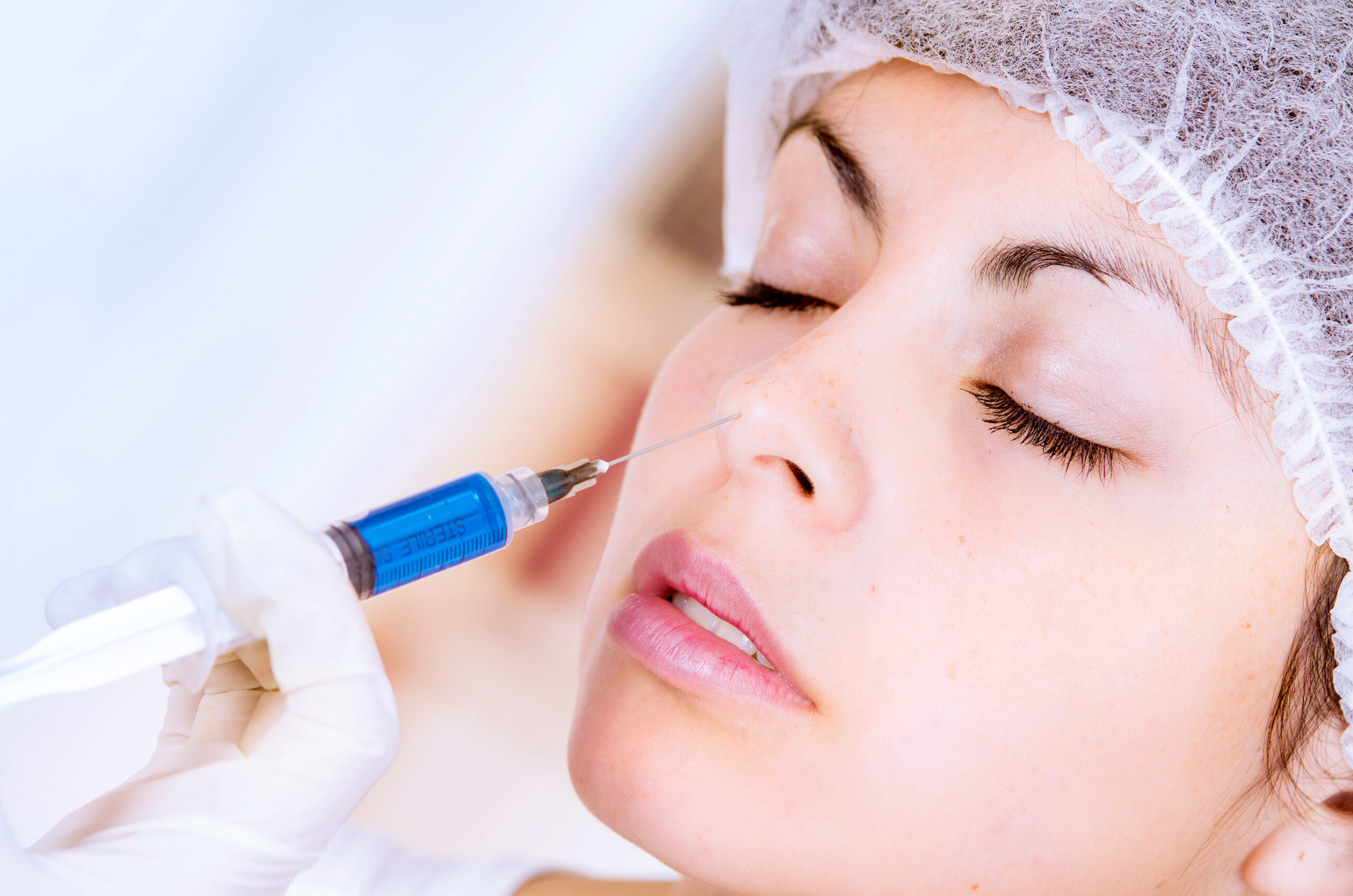
In recent years, the world of cosmetic enhancement has witnessed the emergence of various non-surgical procedures promising quick fixes for aesthetic concerns. One such trend that has gained popularity is “liquid rhinoplasty.” While it may sound appealing to those seeking a nose job without going under the knife, this procedure comes with risks and limitations that make it a risky fad we do not recommend.
What is Liquid Rhinoplasty?
Liquid rhinoplasty, also known as a non-surgical nose job, is a cosmetic procedure involving injecting dermal fillers, such as hyaluronic acid, into the nose to reshape and enhance its appearance. The goal is to address minor imperfections, such as bumps, asymmetry, or a drooping tip, without needing traditional surgical rhinoplasty.
During this procedure, a skilled practitioner utilizes dermal fillers, such as hyaluronic acid-based products, to add volume and strategically sculpt the nasal contours. The injection process involves carefully placing these fillers beneath the skin’s surface, targeting specific areas to create a more balanced and harmonious nose shape. Unlike surgical rhinoplasty, which involves incisions and structural modifications, liquid rhinoplasty is minimally invasive, making it an attractive option for those seeking subtle changes to their nasal appearance. The dermal fillers used are temporary and gradually absorbed by the body over time, allowing for adjustments or reversals if needed.
The appeal of liquid rhinoplasty lies in its non-invasive nature, minimal downtime, and the promise of immediate results. Many individuals are drawn to improving their nose’s appearance without the risks, recovery time, and cost associated with surgical rhinoplasty.
Why We Don’t Do Liquid Rhinoplasties
While liquid rhinoplasty may seem like a convenient solution, it comes with significant risks and limitations that potential patients should be aware of:
- Temporary Results: Unlike surgical rhinoplasty, which offers long-lasting results, liquid rhinoplasty provides only temporary improvements. The effects typically last several months to a year, requiring repeated treatments and costs to maintain the desired appearance.
- Limited Correction: Liquid rhinoplasty is suitable for minor cosmetic issues and cannot address structural or functional problems with the nose. It cannot reduce the size of the nose, correct breathing difficulties, or fix significant deformities.
- Risk of Complications: Any injectable procedure carries the risk of complications, including infection, allergic reactions, and tissue damage. The nose is a sensitive area with a complex vascular network, making it more susceptible to potential complications. Additionally, liquid rhinoplasty carries a risk of skin necrosis and blindness.
- Lack of Reversibility: Unlike other dermal filler procedures, the results of liquid rhinoplasty cannot be as easily reversed. If patients are unhappy with the outcome, they may need to wait for the filler to dissipate or undergo corrective surgery.
- Unregulated Practitioners: The popularity of liquid rhinoplasty has led to an increased number of providers offering the procedure. Unfortunately, not all of them are qualified or experienced in performing nasal injections safely. Choosing an unskilled practitioner can lead to subpar results and potential complications.
- Risk of Overfilling: Overzealous use of dermal fillers can result in an overfilled or unnatural appearance. Achieving a balanced and aesthetically pleasing result requires skill and experience.
Going Blind: The Most Serious Risk Posed By Liquid Nose Jobs
Skin necrosis and the risk of blindness associated with liquid rhinoplasty are rare but severe complications. It occurs when dermal fillers are inadvertently injected into veins around the nose, traveling upstream and blocking blood flow to the eyes. This can lead to permanent vision loss if not promptly treated. While such cases are infrequent – especially when the proper techniques are used – they highlight the importance of choosing a skilled and experienced practitioner for any facial injections, as they can minimize the risk through proper technique and knowledge of facial anatomy.
What We Recommend Instead: Rhinoplasty
At Plastic Surgeons of Northern Arizona, we prioritize patient safety and satisfaction. While liquid rhinoplasty may seem convenient, we strongly recommend traditional surgical rhinoplasty for those seeking more substantial and long-lasting changes to their nose’s appearance or function. Generally, it’s a best practice to avoid administering dermal fillers into any of these “danger zones,” including the glabella/brow, temporal region, perioral region, nasolabial fold, nose, and infraorbital region.
Surgical rhinoplasty, performed by a board-certified plastic surgeon, offers precise control over the reshaping process, permanent results, and the ability to address cosmetic and functional concerns. Our experienced team of surgeons is dedicated to providing personalized care and achieving the best possible outcomes for our patients.
Cost Comparison
Liquid rhinoplasty tends to be a more budget-friendly option up front, with lower initial costs for dermal fillers and the procedure ranging from $500 to $2,500 on average. However, liquid rhinoplasty only provides temporary results, and patients may need periodic touch-up treatments to maintain their desired look, incurring ongoing expenses over time.
In contrast, surgical rhinoplasty involves a one-time cost. The average nationwide surgeon’s fee for a rhinoplasty is $6,300, according to the American Society of Plastic Surgeons, plus the cost of anesthesia and facility fees. While the initial investment in surgery is higher than liquid rhinoplasty, the results are permanent, eliminating the need for continuous treatments. Individuals should weigh the long-term financial implications against their aesthetic goals when deciding between these two rhinoplasty options.
Final Thoughts
While trends in cosmetic enhancement come and go, the safety and effectiveness of the procedures should always be a top priority. Although marketed as a quick and easy solution, liquid rhinoplasty carries significant risks and limitations. At Plastic Surgeons of Northern Arizona, we advise patients to choose rhinoplasty when seeking substantial and lasting improvements to their nose’s appearance and function. Your safety and satisfaction are our utmost concerns, and we are committed to delivering the best possible results through proven and reliable methods.
Book a Rhinoplasty Consultation in Arizona
Our qualified board-certified plastic surgeons at Plastic Surgeons of Northern Arizona would love to meet you to discuss your goals and treatment options. Book a consultation in Flagstaff, Sedona, Cottonwood, Prescott Valley, or Kingman today.
Author Profile: Brian Cripe, M.D., is an award-winning, board-eligible plastic and reconstructive surgeon proudly working with the Plastic Surgeons of Northern Arizona practice. Dr. Cripe specializes in cosmetic surgery, limb salvage, peripheral nerve microsurgery, hand surgery, and oncologic reconstructive procedures. He has performed over 5,000 surgical cases during his nine-year tenure as a surgeon.



